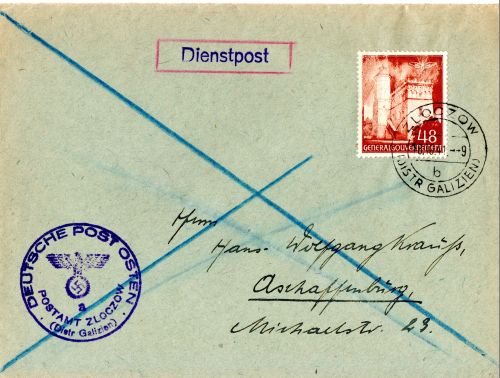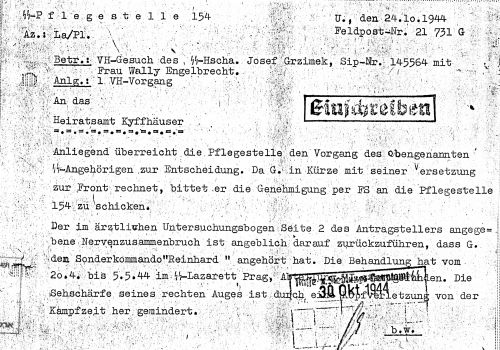Zloczow

Zloczow - Envelope posted to Aschaffenburg (Tall Trees Archive)
Zloczow is located 40 miles east of Lwow. On the eve of the Second World War, there were approximately 7,800 Jews living in Zloczow.
German forces occupied Zloczow on July 2, 1941. At first a German military commandant's office (Ortskommandantur) governed the town. A German civilian administration took over control in August 1942. Zloczow became the administrative centre of Kreis Zloczow, within Distrikt Galizien. Until January 1943, the Kreishauptmann was Regierungsassessor Hans Mann. He was then replaced by Dr. Otto Wendt. Until the autumn, the Security Police outpost (Sipo -Aussendienststelle) in Tarnopol organised and carried out the anti-Jewish 'Aktionen' in Zloczow. Subsequently, that function shifted to the office of the Sipo and SD in Lemberg (Lwow) and the post of the Kripo (Criminal Police) based in Zloczow, which was headed by a Kripo official, Otto Sigmund, who originally hailed from Vienna.
According to a German Einsatzgruppen report, 'before the Russians fled, they arrested and murdered in Zloczow approximately 700 Ukrainians' In retribution the Ukrainian militia arrested several hundred Jews and shot them, under instructions from the Wehrmacht. The number of Jews killed was between 300 and 500. A mobile group of the Organisation of Ukrainian Nationalists (OUN), led by I.Klymiv initiated the pogrom.
On July 3, members of this group rounded up and confined hundreds of Jews in a fortress. There they made the Jews dig up the victims of the Soviet People's Commissariat of Internal Affairs (NKVD) with their bare hands. Then they killed the Jews on the spot, and the slaughter spread into the town itself. The killings went on for four days. The number of Jews who lost their lives was approximately 1,400. Several days later, on July 10, a detachment of Security Police , which was part of Einsatzgruppe z.b.v. shot another 300 Jews, selected from the town's professionals.
On orders from the German administration, the Jews in Zloczow formed a 12-man Jewish Council (Judenrat), headed by Dr. Sigmunt Majblum. Subsequently, a Jewish Police (Ordnungsdienst) under the command of D.Landsberg, was established. Jews were ordered to wear white armbands bearing the Star of David. The Germans confiscated most of the Jews belongings, particularly items of value, and they introduced a series of restrictive measures against the Jews. Jews were required to register and to perform various kinds of hard labour, for little or no pay, and they were not permitted to leave the limits of the town. The Germans also imposed a large financial contribution on the Jews, which was paid by the Judenrat.
In the autumn of 1941, the German authorities confiscated all Jewish owned apartments and evicted those Jews living on the town's main streets. A curfew was also enforced from 6:00 p.m. to 6:00 a.m. and Jews were not permitted to shop after 10:00 a.m. In November 1941, and also at the beginning of 1942, the German authorities sent several hundred Jews to the labour camps in Lackie Wielkie, leaving 5,833 Jews in the town. Soon a typhus epidemic broke out in the camp, and it quickly spread to the Jews in Zloczow.
As many Jews had no source of income, from the onset of the occupation, people had to barter their remaining possessions for food, at exorbitant prices. In the spring of 1942, the Judenrat organised a soup kitchen to aid the poor. There was also a small hospital, staffed with Jewish doctors. In July 1942, another group of young Jewish men were rounded up, and they were sent to the labour camps in Sasow, Lackie Wielkie, Pluhow and Kozaki.
An open ghetto was established in Zloczow, probably in the spring of 1942, before the establishment of the enclosed ghetto that followed in December 1942. The Jews were concentrated in one part of the town, but could still move around within the town's limits.
In mid-August 1942, the Judenrat was ordered to prepare a list of 2,500 Jews unfit for work. In the course of the first mass deportation 'Aktion' on August 28 -29, 1942, the Germans deported approximately 2,000 Jews to the Belzec death camp. The Sipo -Aussendienststelle in Tarnopol, headed by SS- Sturmbannfuhrer Hermann Muller, carried out the 'Aktion' with the assistance of German and Ukrainian policemen and members of the Jewish Order Service. After this 'Aktion' 4,172 Jews remained in Zloczow. But the Jews were not safe.
A second 'Aktion' took place on November 2, 1942, during which time, another 2,500 were sent to the Belzec death camp. A detachment of the Security Police from Lemberg, under the command of SS-Oberscharfuhrer Karl Wobke, together with members of the German Gendarmerie and Ukrainian police carried out the 'Aktion.' Initially, the combined police forces combed the residential Jewish area, which at the time was not enclosed by a fence, and assembled the Jews thus rounded up, at the so-called 'Green Ring.' From there the Jews were escorted in groups to the railway station. Many Jews were shot on the spot during the 'Aktion.'
On December 1, 1942, the Germans established an enclosed ghetto in Zloczow, in which they confined the surviving Jews from the town itself, as well as those Jews brought in from surrounding villages, such as Gologory, and Sasow. Herman Zeigler recalled that announcements were posted on the walls in Sasow, ordering the Jews to move to Zloczow within one week. The Jewish workers incarcerated in the Sasow Labour Camp were excluded, but all their family members were transferred.
All told, there were approximately 4,000 Jews confined in the Zloczow ghetto, which was located on Mickiewicz Street and Targowa Street. It was enclosed using barbed wire as well as, existing house walls. There was only one gate, which was guarded by Ukrainian police. The severe overcrowding and poor sanitary conditions soon led to a typhus epidemic. Subsequently, the typhus epidemic served as the grounds for liquidating the ghetto. Some sources indicate that the head of the Judenrat, Dr. Sigmunt Majblum, refused to sign a document declaring that the ghetto was being liquidated because of the typhus epidemic, and he was murdered. The Deputy Kreishauptmann Gerhard von Jordan, apparently played a sinister role in the destruction of the ghetto. He claimed to have ordered the liquidation in a document he signed using the fictitious title, 'Politruk -SS.'
A German Security Police detachment, accompanied also by members of the Jewish Order Service from Lemberg, as well as members from the local Gendarmerie and Ukrainian police, promptly liquidated the ghetto in an 'Aktion' that was carried out on April 3 -4, 1943. In total some 3,500 Jews were shot near the village of Jelechowice. Many Jews had prepared bunkers and hiding places within the ghetto to avoid the manhunts and shootings continued for several weeks afterwards, as German and Ukrainian forces continued to search for those Jews in hiding.

Document from the personal file of Josef Grzimek (Yad Vashem)
A Labour Camp remained in the town, after the liquidation of the ghetto. The German authorities had established the camp towards the end of 1942, under the command of SS-Hauptscharfuhrer Josef Grzimek. The prisoners in the camp were employed in a workshop and on the construction of a railway line. The Germans liquidated the labour camp in July 1943.
Thanks to the help and backing of Josef Meyer, the Kreislandwirt in Zloczow, a group of Jews managed to survive. Until November 1942, Meyer did not believe that the Germans were exterminating Jews in gas chambers. When he finally grasped this reality, he did his utmost to help them. He made reasonable arrangements for the work to which they were assigned; he saw to their food supplies and he gave them the chance to hide during the round-ups. In Israel after the war, Meyer was awarded the title 'Righteous Among the Nations,' by Yad Vashem.
Two secret groups were established in the Jewish Labour Camp. P. Nachumovits led one group, whilst H.Safran led the other group. The group headed by P. Nachumovits - about 30 strong - managed to escape into the woods, where they tried to prepare a bunker. However, peasants in a neighbouring village betrayed them to the Germans, who murdered most of the group. The members of the Safran group also met the same fate, and they too were arrested and killed. Safran himself, at the time of the shooting, jumped one of the Germans and grabbed his pistol. He was shot and killed in the back by one of the Ukrainian police.
After the war, Otto Wendt, in civilian life became a Staatssekretar in Lower Saxony. For a while. he was under investigation by the authorities, but this was discontinued during 1969. Otto Sigmund was extradited to the Soviet Union in 1949, where he was tried and sentenced to a prison term. He died in a Soviet prison. Hermann Muller was sentenced to life in prison, for his part in the killings of the Jews in Zloczow and other places.
Sources
Encyclopaedia of Camps and Ghettos 1933- 1945, USHMM, Indianna University Press Bloomington and Indianapolis 2012
Envelope - Tall Trees Archive
Document - Yad Vashem, Israel
© Holocaust Historical Society 2019

